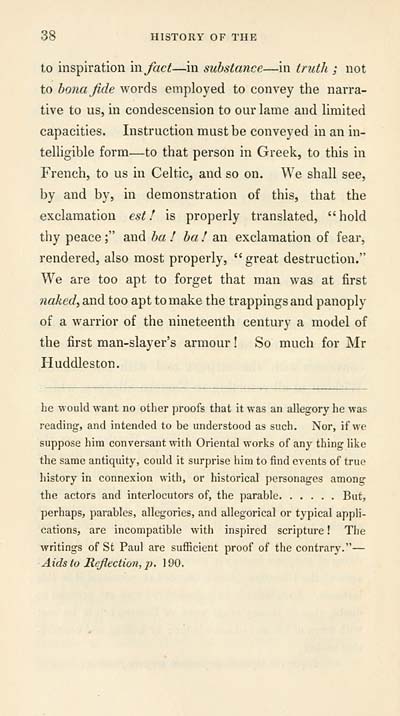Download files
Complete book:
Individual page:
Thumbnail gallery: Grid view | List view

38 HISTORY OF THE
to inspiration mfact — in substance — in truth ; not
to bona fide words employed to convey the narra-
tive to us, in condescension to our lame and limited
capacities. Instruction must be conveyed in an in-
telligible form — to that person in Greek, to this in
French, to us in Celtic, and so on. We shall see,
by and by, in demonstration of this, that the
exclamation est! is properly translated, "hold
thy peace ;" and ba ! ba ! an exclamation of fear,
rendered, also most properly, " great destruction."
We are too apt to forget that man was at first
nakedy and too apt to make the trappings and panoply
of a warrior of the nineteenth century a model of
the first man-slayer's armour ! So much for Mr
Huddles ton.
he would want no other proofs that it was an allegory he was
reading, and intended to be understood as such. Nor, if we
suppose him conversant with Oriental works of any thing like
the same antiquity, could it surprise him to find events of true
history in connexion with, or historical personages among
the actors and interlocutors of, the parable But,
perhaps, parables, allegories, and allegorical or typical appli-
cations, are incompatible with inspired scripture ! The
writings of St Paul are sufficient proof of the contrary." —
Aids to Reflection, p. 190.
to inspiration mfact — in substance — in truth ; not
to bona fide words employed to convey the narra-
tive to us, in condescension to our lame and limited
capacities. Instruction must be conveyed in an in-
telligible form — to that person in Greek, to this in
French, to us in Celtic, and so on. We shall see,
by and by, in demonstration of this, that the
exclamation est! is properly translated, "hold
thy peace ;" and ba ! ba ! an exclamation of fear,
rendered, also most properly, " great destruction."
We are too apt to forget that man was at first
nakedy and too apt to make the trappings and panoply
of a warrior of the nineteenth century a model of
the first man-slayer's armour ! So much for Mr
Huddles ton.
he would want no other proofs that it was an allegory he was
reading, and intended to be understood as such. Nor, if we
suppose him conversant with Oriental works of any thing like
the same antiquity, could it surprise him to find events of true
history in connexion with, or historical personages among
the actors and interlocutors of, the parable But,
perhaps, parables, allegories, and allegorical or typical appli-
cations, are incompatible with inspired scripture ! The
writings of St Paul are sufficient proof of the contrary." —
Aids to Reflection, p. 190.
Set display mode to: Large image | Transcription
Images and transcriptions on this page, including medium image downloads, may be used under the Creative Commons Attribution 4.0 International Licence unless otherwise stated. ![]()
| Early Gaelic Book Collections > Blair Collection > History of the Celtic language > (44) |
|---|
| Permanent URL | https://digital.nls.uk/76179093 |
|---|
| Description | A selection of books from a collection of more than 500 titles, mostly on religious and literary topics. Also includes some material dealing with other Celtic languages and societies. Collection created towards the end of the 19th century by Lady Evelyn Stewart Murray. |
|---|
| Description | Selected items from five 'Special and Named Printed Collections'. Includes books in Gaelic and other Celtic languages, works about the Gaels, their languages, literature, culture and history. |
|---|

